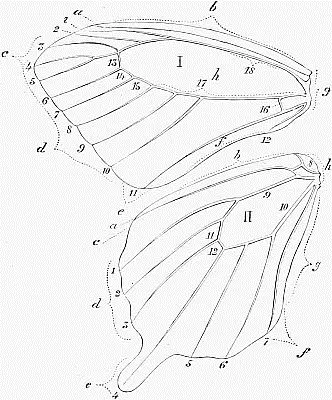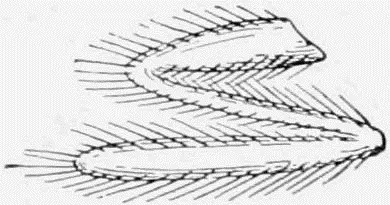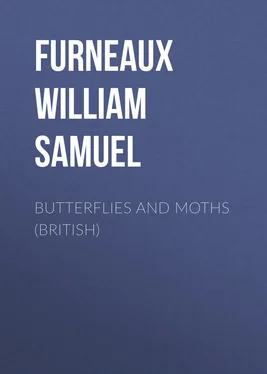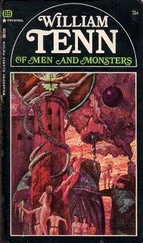William Furneaux - Butterflies and Moths (British)
Здесь есть возможность читать онлайн «William Furneaux - Butterflies and Moths (British)» — ознакомительный отрывок электронной книги совершенно бесплатно, а после прочтения отрывка купить полную версию. В некоторых случаях можно слушать аудио, скачать через торрент в формате fb2 и присутствует краткое содержание. Жанр: Природа и животные, foreign_antique, foreign_prose, на английском языке. Описание произведения, (предисловие) а так же отзывы посетителей доступны на портале библиотеки ЛибКат.
- Название:Butterflies and Moths (British)
- Автор:
- Жанр:
- Год:неизвестен
- ISBN:нет данных
- Рейтинг книги:5 / 5. Голосов: 1
-
Избранное:Добавить в избранное
- Отзывы:
-
Ваша оценка:
- 100
- 1
- 2
- 3
- 4
- 5
Butterflies and Moths (British): краткое содержание, описание и аннотация
Предлагаем к чтению аннотацию, описание, краткое содержание или предисловие (зависит от того, что написал сам автор книги «Butterflies and Moths (British)»). Если вы не нашли необходимую информацию о книге — напишите в комментариях, мы постараемся отыскать её.
Butterflies and Moths (British) — читать онлайн ознакомительный отрывок
Ниже представлен текст книги, разбитый по страницам. Система сохранения места последней прочитанной страницы, позволяет с удобством читать онлайн бесплатно книгу «Butterflies and Moths (British)», без необходимости каждый раз заново искать на чём Вы остановились. Поставьте закладку, и сможете в любой момент перейти на страницу, на которой закончили чтение.
Интервал:
Закладка:
When this organ is not in use, it is beautifully coiled into a close spiral which lies between the labial palpi. The length varies considerably in different insects, and consequently the number of turns in the spiral must differ also. Sometimes there are less than two turns, while some of the longer ones form spirals of from six to ten turns.
In concluding our brief account of the head of lepidopterous insects it is, I suppose, hardly necessary to add that there is no kind of chewing apparatus to be described; all the members of this order, at least in the perfect state, deriving the whole of the little nourishment they require entirely by suction through the proboscis or 'trunk.'
The second division of the body is the thorax . This is much larger than the head, and consists of three ring-like segments, joined one behind the other so intimately that the lines of junction are hardly visible, even after the thick clothing of fine hair has been brushed off. Behind the thorax is the abdomen, which is composed of several segments, the junctions between the rings often being most distinct.

Fig. 8. – Diagram of the Wings of a Butterfly.
I. Fore wing. – 1-5, subcostal nervules; 6, 7, discoidal nervules; 8-10, median nervules; 11, submedian nervure; 12, internal nervure; 13-15, disco-cellular nervules; 16, interno-median nervule; 17, median nervure; 18, subcostal nervure; a , costal nervure; b , costa or anterior margin; c , apex or anterior angle; d , posterior or hind margin; e , posterior or anal angle; f , interior or inner margin; g , base; h , discoidal cell.
II. Hind wing. – 1, 2, subcostal nervules; 3, discoidal nervule; 4-6, median nervules; 7, submedian nervure; 8, precostal nervure; 9, subcostal nervure; 10, median nervure; 11, 12, disco-cellular nervules; a , costal nervure; b , costa or anterior margin; c , apex or anterior angle; d , hind margin; e , tail or caudal appendage; f , anal angle; g , abdominal or inner margin; h , base.
From the sides of the thorax proceed the two pairs of wings, the general structure of which we have already to a certain extent examined. But when we are a little farther advanced in our insect studies, we shall have to become acquainted with detailed descriptions given as aids to the identification of species. Now, such descriptions cannot be satisfactory, either to the one who gives or to him who receives, unless expressed in such definite terms as render a misunderstanding impossible. A botanist cannot give an accurate and concise description of a flower without the use of certain names and expressions which have gradually become an almost necessary part of his vocabulary; neither can an entomologist give a really useful, and, at the same time, a succinct description of an insect unless he is acquainted with the names of its parts. Therefore, seeing that we distinguish the various species of butterflies and moths mainly by the arrangement and colour of the markings of their wings, it is really necessary that we should know the names of the different parts of these organs. For this reason I have inserted drawings of a fore and of a hind wing of a butterfly, together with the names of the various parts of the wings, and also the names of the principal rays or nervures . Yet I would not advise any young entomologist to attempt to commit to memory all the names given. Rather use the diagram for reference when occasion requires, more particularly when you have an insect in your possession that you desire to study. In ordinary descriptions of butterflies and moths the names of the nervures are not so generally used as those of the parts of the wing. Consequently it is exceedingly useful to know what is meant by the terms base , costal margin , apex , hind margin , anal angle , inner margin , discoidal cell &c. as applied to the wing.
The two pairs of wings are attached to the second and third segments of the thorax; but of the three pairs of legs, which we have next to consider, one pair arises from each of the three segments. The arrangement of these limbs is well shown in the sketch on page 3, as are also the names of the different parts of the limb, the latter being given for reference by the reader when the need arises.
All insects, in their perfect state, we are told, have three pairs of legs; but if you examine the under surface of certain butterflies, such as the Marbled White, or any of the Vanessas, Browns, or Heaths, it is quite likely that you will raise objection to such a statement; for in these you may possibly see only four legs. But this is the result of a too cursory observation. Look a little more closely at your specimen, and you will see a pair of smaller legs folded up under the fore part of the thorax. By means of a blunt needle you can straighten out these limbs, and then the difference in length to be observed between them and the other four is very striking indeed. They are also thinner than the middle and hind legs; and, unlike these, are not provided with claws.

Fig. 9. – The Undeveloped Fore Leg of a Butterfly.
These imperfectly developed legs are, of course, quite useless as far as walking is concerned; indeed, it is extremely doubtful as to whether they are of any service whatever to the owner. On one occasion, however, while watching a Peacock Butterfly apparently engaged in cleaning its divided proboscis, I observed that this organ was frequently passed under the thorax, and that the front pair of legs were pressed against it on each side, while it was being drawn outward between them. It is probable, therefore, that these limbs constitute a pair of brushes by means of which the fine grooves of the divided trunk are cleared of any solid or sticky matter that may lodge therein. It is certain that moths, and those butterflies that possess six equal legs, use the front pair for this same purpose. The former, also, employ them for brushing their antennæ, which seem to be, by the way, particularly sensitive to different kinds of irritation.
It is a well-known fact that tobacco smoke has a powerful influence on certain small insects; and even though it can hardly be regarded as a perfect all-round insecticide, it is certainly more or less objectionable to the larger and hardier species. A short time since, while watching a number of newly emerged moths of the Sphinx group, and at the same time enjoying the solace afforded by the luxurious weed, a puff of the smoke was accidentally allowed to play into the box in which my pets were for the time imprisoned. Immediately they rubbed their front legs vigorously over the antennæ, as if to remove the obnoxious irritant that had thus intruded on their presence. Similar observations have led many naturalists to suppose that the antennæ are the seat of various senses, such as those of touch, hearing, and smell. Seeing that insects do not, as far as we know, possess special organs for all the five senses which we enjoy (and it is interesting to note here that some insects certainly experience other sensations which are quite beyond our ken), we can quite understand the common tendency to locate the seats of certain of the senses in such easily affected parts as the antennæ. But little, I believe, has been definitely proved save that the antennæ are sensitive to touch and to irritants generally.
Читать дальшеИнтервал:
Закладка:
Похожие книги на «Butterflies and Moths (British)»
Представляем Вашему вниманию похожие книги на «Butterflies and Moths (British)» списком для выбора. Мы отобрали схожую по названию и смыслу литературу в надежде предоставить читателям больше вариантов отыскать новые, интересные, ещё непрочитанные произведения.
Обсуждение, отзывы о книге «Butterflies and Moths (British)» и просто собственные мнения читателей. Оставьте ваши комментарии, напишите, что Вы думаете о произведении, его смысле или главных героях. Укажите что конкретно понравилось, а что нет, и почему Вы так считаете.












